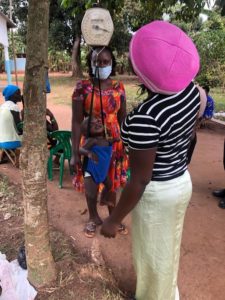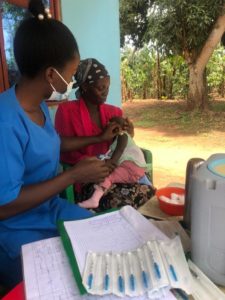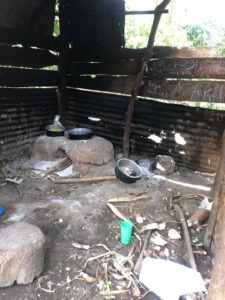Sorry for the late entry! Yesterday was a very full day. I followed the community health services (CHS) team into the community for home visits and vaccine/antenatal clinic. Anyone who knows me knows I must have been in my happy place at community antenatal clinic and they would be right. It was really a unique and interesting experience, and I got lucky because the antenatal clinic only occurs on the second Thursday of each month so this was my only chance to see it. We left mid morning in a red converted matutu (see below) and started by dropping off two nurses for the clinics. Apart from these nurses, the team consisted of a psychiatric nurse, a social worker, and our driver. We started by visiting patients in or near their homes that had either epilepsy or mental health needs. For these home visits, the team carried with them basic psychiatric meds including haloperidol tablets, phenytoin tablets, phenobarbital tablets, and carbamazepine tablets. We would either get out of the van and see the patient in their home or, if their home was not large enough for many visitors or if the patient did not want us in their home they would join us in the van. Locating the patient included asking neighbors and anyone we saw on the street near their home if they had seen them that day. We ended up seeing three patients of various ages who had epilepsy and a young man with HIV psychosis. This man was very unstable, randomly taking his HIV medications, and had completely stopped his Haldol tablets. Because of this, the team decided to begin him on Haldol intramuscular shots monthly which they were planning to take to him the next week.
After finishing home visits, we circled back to the vaccine and antenatal clinic. These clinics are organized by teams called vaccine home health teams which include women in the villages that identify a time and a place for these clinics to occur and then spread the word by mouth to the parents of the community with children who need vaccination. The vaccine schedule is fairly similar to the US with a couple key differences. One difference was that the child receives BCG (tuberculosis) and oral polio vaccines at birth as well as several doses of oral polio vaccine in the first year. In the US, we only use the intramuscular version typically and do not administer the BCG vaccine. Otherwise, the other routine vaccinations are similar including pneumonia, DTaP, HIB, rotavirus, and hepatitis B. I do not remember seeing influenza on the vaccination chart but forgot to ask specifically. The vaccines were given on the porch of a local woman’s house and babies were weighed by hanging a canvas swing from a scale similar to those you would use for fruits and vegetables in the supermarket (see below). The nurses also took these opportunities to do some education on nutrition and safety for the mothers while their children were getting vaccinated.
The antenatal clinic was occurring in the front room of the house on a straw mat on the floor. Women came for prenatal appointments, postpartum visits, and to discuss family planning options. Medications that are brought for this clinic include Depo-Provera, Tdap vaccines, Tylenol, HIV medications, and tranexamic acid . Routine medications given to all pregnant mothers include malaria prophylaxis, prenatal vitamins with iron, mebendazole for deworming, and mosquito nets if needed. The mothers pay 2000 Ugandan shillings (less than $1) at their initial prenatal appointment, but there is no further charge after this. If the mother does not have an HIV or syphilis result in the past six months, a rapid test for either or both is completed. Physical exam is the same as I am used to except there is no Doppler machine to listen to the fetal heart and instead we auscultate this with a fetoscope which is an aluminum instrument with a cone on one end attached to a listening area (maybe just Google it as I am sure I am explaining it poorly!). This is surprisingly difficult and I feel more appreciative of the ease of Doppler technology. If there are any issues that the nurse is uncomfortable with or needs further evaluation then they are able to come back to the hospital in the van with us, but thankfully all the mothers were healthy. The documentation is hand written and the mothers are given a pink card which they are instructed to bring to every appointment related to the pregnancy whether in the community or at the hospital. Just like the outpatient department, each patient’s details are recorded in a Uganda Ministry of Health book for each antenatal appointment which includes name, age, how many times they’ve been pregnant and how many children they have, their village, the number of international appointments they have had for this pregnancy, if they have received the medications listed above, if they have any symptoms of tuberculosis, any significant physical exam findings, and what their HIV and syphilis status is. Providing this service to the community, even though the hospital may never be involved further in these women’s care, is extremely vital and so useful in a country where most mothers do not receive even one prenatal appointment and many choose to deliver outside of the hospital.
Lugandan word of the day: oli otya (“oh-lee oh-cha”, informal greeting to one person- hello)
Medical learning point of the day: When ultrasound is unavailable, calculate the due date for a pregnancy based off the earliest fundal height available. Use this calculation if the last menstrual period is unknown or if the fundal height was obtained during the second trimester, otherwise use the last menstrual period.




